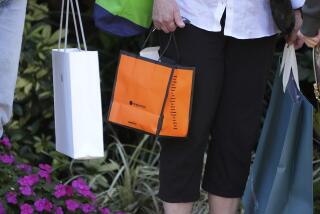Retail sales climb a healthy 4.2% in January
The usual post-Christmas shopping fatigue and miserable weather through most parts of the country didn’t keep Americans away from the malls last month, but rising costs may challenge retailers in the months ahead.
Major chain stores posted an impressive 4.2% sales increase in January compared with the same month a year earlier, handily exceeding analysts’ expectations of a modest 2.7% rise. Discounters, department stores and apparel sellers all posted healthy sales increases, according to Thomson Reuters’ tally of 28 retailers.
“We’re definitely spending more,” said Stacey Johnson, 39, who was hitting up her favorite stores at Waterside shopping center in Marina del Rey recently. “A year ago, we were afraid to spend money.”
But with the economy still in recovery, Johnson, a stay-at-home wife from Marina del Rey, said she’s become more of a bargain hunter.
“I’m definitely looking for sales now, where in a previous life it didn’t really matter,” she said. “Now I just think it’s more appropriate.”
After a solid holiday season and with consumer spending appearing to stabilize, economists and retail watchers are looking for more widespread improvement among other economic sectors.
“The final things that need to click into place here would be significant improvement in the unemployment rate and some improvement in the housing market,” said Ken Perkins, president of Retail Metrics Inc. “If we can see those things materialize, I think that would go a long way and would offset lingering head winds that are on the horizon.”
Among retailers’ biggest worries: Higher cotton prices, as well as increased labor and transportation costs, which could hinder business in the coming months.
Merchants including Gap Inc. and J.C. Penney Co. have warned that the rise in cotton prices means they may have to pay Chinese suppliers at least 20% more for clothing. And analysts have cautioned that U.S. consumers will probably pay more for their shirts, sheets and socks this year.
But those concerns haven’t hit consumers’ wallets yet.
In January, sales were helped by after-Christmas discounts intended to clear leftover merchandise. Although snowstorms negatively impacted sales in some areas, they also boosted demand for winter clothing such as scarves, jackets and boots.
All told, 68% of retailers beat expectations, Thomson Reuters said. The strong showing was especially encouraging because it was being compared against a healthy January 2010.
The results were led by Limited Brands, parent company of Victoria’s Secret and Bath and Body Works, which blew past estimates for a 6.7% increase with a massive 24% rise. Action sports chain Zumiez Inc. saw sales surge 15.3%, and Costco Wholesale Corp. said sales were up 9%.
“Retailers weathered the storms in January, both literally and figuratively,” said Michael Niemira, chief economist at the International Council of Shopping Centers. “This gain is encouraging especially given the drag on sales created by the winter storms in the Northeast and Southeast, and suggests relatively healthy underlying consumer demand.”
The one laggard last month was the teen apparel category, which saw a 2% decline. That was a disappointment because teens are often seen as a barometer of discretionary spending because they aren’t hampered by debt, bills and other responsibilities.
Abercrombie & Fitch Co., which had been on a sales rebound in recent months, posted a 4% drop; American Eagle Outfitters Inc. said sales fell 6%; and Hot Topic Inc. saw a 3.3% decline.
Results are based on sales at stores open at least a year, known as same-store sales and considered an important barometer of a retailer’s health because it excludes store openings and closures.
Separately, Abercrombie, American Eagle and Aeropostale Inc. announced that they would stop reporting sales on a monthly basis after January’s results.
The move — which follows similar decisions by other large retailers including discount giant Wal-Mart Stores Inc. and Anaheim-based Pacific Sunwear of California Inc. — is seen as an effort to avoid stock volatility. Many retail executives say reporting sales on a monthly basis puts too much of a focus on short-term results.
But losing such a large chunk of merchants from the monthly retail reports may make it harder for analysts and economists to get a read on the overall industry, they said.
“It’s too bad for institutional and individual investors,” Perkins, of Retail Metrics, said. “I think people like to see as much information as possible that’s out there to make the best possible decision, so it is a bit discouraging from that perspective.”
Although consumers appear to be spending less cautiously, many say they’re not splurging.
Val Guin of Hollywood said her finances have stabilized in recent months and she’s feeling more optimistic about the economy. But Guin is still clipping coupons and “nothing was frivolous at all” over the holidays, she said.
“I could go out and buy a new couch or a new computer or a new car,” she said, “but I’m choosing not to.”
More to Read
Inside the business of entertainment
The Wide Shot brings you news, analysis and insights on everything from streaming wars to production — and what it all means for the future.
You may occasionally receive promotional content from the Los Angeles Times.










